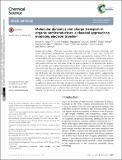Molecular dynamics and charge transport in organic semiconductors: a classical approach to modeling electron transfer
Author(s)
Pelzer, Kenley M.; Vázquez-Mayagoitia, Álvaro; Ratcliff, Laura E.; Tretiak, Sergei; Bair, Raymond A.; Gray, Stephen K.; Larsen, Ross E.; Darling, Seth B.; Van Voorhis, Troy; ... Show more Show less
Downloadc6sc04547b.pdf (1.343Mb)
PUBLISHER_CC
Publisher with Creative Commons License
Creative Commons Attribution
Terms of use
Metadata
Show full item recordAbstract
Organic photovoltaics (OPVs) are a promising carbon-neutral energy conversion technology, with recent improvements pushing power conversion efficiencies over 10%. A major factor limiting OPV performance is inefficiency of charge transport in organic semiconducting materials (OSCs). Due to strong coupling with lattice degrees of freedom, the charges form polarons, localized quasi-particles comprised of charges dressed with phonons. These polarons can be conceptualized as pseudo-atoms with a greater effective mass than a bare charge. We propose that due to this increased mass, polarons can be modeled with Langevin molecular dynamics (LMD), a classical approach with a computational cost much lower than most quantum mechanical methods. Here we present LMD simulations of charge transfer between a pair of fullerene molecules, which commonly serve as electron acceptors in OSCs. We find transfer rates consistent with experimental measurements of charge mobility, suggesting that this method may provide quantitative predictions of efficiency when used to simulate materials on the device scale. Our approach also offers information that is not captured in the overall transfer rate or mobility: in the simulation data, we observe exactly when and why intermolecular transfer events occur. In addition, we demonstrate that these simulations can shed light on the properties of polarons in OSCs. Much remains to be learned about these quasi-particles, and there are no widely accepted methods for calculating properties such as effective mass and friction. Our model offers a promising approach to exploring mass and friction as well as providing insight into the details of polaron transport in OSCs.
Date issued
2017-01Department
Massachusetts Institute of Technology. Department of ChemistryJournal
Chemical Science
Publisher
Royal Society of Chemistry (RSC)
Citation
Pelzer, Kenley M. et al. “Molecular Dynamics and Charge Transport in Organic Semiconductors: a Classical Approach to Modeling Electron Transfer.” Chemical Science 8, 4 (2017): 2597–2609 © The Royal Society of Chemistry
Version: Final published version
ISSN
2041-6520
2041-6539